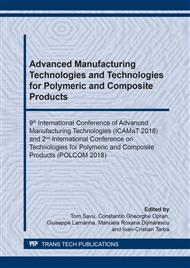p.120
p.130
p.138
p.148
p.156
p.167
p.179
p.187
p.195
A Dynamic Model for KUKA KR6 in SPIF Processes
Abstract:
The paper presents the development of a dynamic model for the KUKA KR6 robot during single point incremental forming (SPIF) of metal sheets. The dynamic model of the KUKA KR6 robot is created in MATLAB®-SimMechanics. This dynamic model is necessary to verify that the mechanical structure of this low payload industrial robot of 36 Kg capacity can withstand some specific forces in incremental forming of some low plasticity alloys like Ti6Al4V. In the Centre of Studies and Research for Plastic Deformations of "Lucian Blaga" University of Sibiu, different attempts on single point incremental forming of thin metal sheets have been carried out and some of the studies are based on SPIF using the KUKA KR6-2 industrial robot. Nevertheless, the previous experimental attempts using the KUKA KR 6-2 robot in SPIF processes were realised only on 0.4 mm thick DC04 steel sheets. This material has very good deformability properties and the forces during the process are relatively small. After the dynamic model validation some specific circular trajectories are imposed and the forces that can appear during SPIF process for Ti6Al4V alloy sheets are taken into consideration. After forces analysis, it was concluded that the KUKA KR6 robot can be used in single point incremental forming processes for metal parts requiring greater forming forces.
Info:
Periodical:
Pages:
156-166
Citation:
Online since:
June 2019
Authors:
Keywords:
Price:
Сopyright:
© 2019 Trans Tech Publications Ltd. All Rights Reserved
Share:
Citation:


